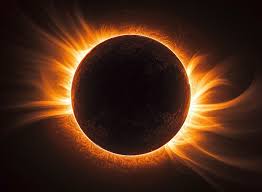Heavenly Alignment: Unveiling the Mystery of Solar Eclipses
Have you ever looked up at the bright sun and wondered what it would be like if it disappeared? Well, during a solar eclipse, that’s exactly what happens – for a brief moment, at least. This celestial spectacle occurs when the Moon steps in between the Earth and the Sun, casting a shadow on our planet and blocking out the Sun’s dazzling light.
But how exactly does this cosmic game of hide-and-seek play out? It all boils down to a fascinating alignment. The Moon, in its constant dance around Earth, occasionally finds itself positioned directly between us and the Sun. When this happens, the Moon casts two main types of shadows: the umbra and the penumbra. The umbra is the darkest part of the shadow, where the Moon completely blocks the Sun’s light. The penumbra is a lighter, fringe region where the Sun is only partially obscured.
Here’s where things get exciting: depending on where you are on Earth relative to these shadows, you’ll experience a different kind of eclipse. If you find yourself standing directly under the umbra, you’ll witness a total solar eclipse – the most dramatic of the bunch. During totality, the sky darkens considerably, as if night has fallen prematurely. The Sun’s brilliant face is replaced by a dark circle, and the Sun’s wispy outer atmosphere, the corona, becomes visible. It’s an awe-inspiring sight, a testament to the intricate movements of celestial bodies.
However, totality only occurs along a narrow path on Earth, the path of totality. If you’re outside this path but still within the penumbra, you’ll see a partial solar eclipse. In this case, the Moon will appear to take a bite out of the Sun, but the sky won’t darken significantly.
Now, the big question: how can you safely witness this celestial wonder? Observing a solar eclipse directly is never safe. Looking at the Sun, even during a partial eclipse, can cause permanent eye damage. Here’s where special eclipse glasses come in. These glasses have specially designed filters that drastically reduce the Sun’s intensity, allowing you to view the eclipse without harming your eyes.
Another safe viewing method is the pinhole projector. This simple device creates an indirect image of the Sun on a surface, allowing you to observe the eclipse without looking directly at the Sun itself.
Solar eclipses have captivated humanity for centuries. They were once seen as harbingers of bad omens, but today, they represent a chance to learn more about the Sun, the Moon, and the delicate dance they perform in our solar system. So, the next time a solar eclipse graces our skies, be sure to equip yourself with the proper safety gear and prepare to witness a truly unforgettable astronomical event.
Follow google news channel to get news of amar sokal 24 newspaper











